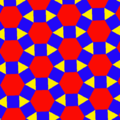Tetrahedral-triangular tiling honeycomb
Appearance
| Tetrahedral-triangular tiling honeycomb | |
|---|---|
| Type | Semiregular honeycomb
|
| Schläfli symbol | {(3,6,3,3)} or {(3,3,6,3)} |
Coxeter diagram |
|
| Cells | {3,3} {3,6} r{3,3} |
| Faces | triangular {3} {6}
hexagon |
| Vertex figure |  rhombitrihexagonal tiling |
| Coxeter group | [(6,3,3,3)] |
| Properties | Vertex-transitive, edge-transitive |
In the
paracompact uniform honeycomb, constructed from triangular tiling, tetrahedron, and octahedron cells, in an icosidodecahedron vertex figure
. It has a single-ring Coxeter diagram, A geometric honeycomb is a space-filling of polyhedral or higher-dimensional cells, so that there are no gaps. It is an example of the more general mathematical tiling or tessellation in any number of dimensions.
Honeycombs are usually constructed in ordinary
circumsphere
to form a uniform honeycomb in spherical space.
It represents a
semiregular honeycomb as defined by all regular cells, although from the Wythoff construction, rectified tetrahedral r{3,3}, becomes the regular octahedron
{3,4}.
See also
- Convex uniform honeycombs in hyperbolic space
- List of regular polytopes
References
- ISBN 0-486-61480-8. (Tables I and II: Regular polytopes and honeycombs, pp. 294–296)
- ISBN 0-486-40919-8(Chapter 10: Regular honeycombs in hyperbolic space, Summary tables II, III, IV, V, p212-213)
- ISBN 0-8247-0709-5(Chapter 16-17: Geometries on Three-manifolds I, II)
- Norman Johnson Uniform Polytopes, Manuscript
- N.W. Johnson: The Theory of Uniform Polytopes and Honeycombs, Ph.D. Dissertation, University of Toronto, 1966
- N.W. Johnson: Geometries and Transformations, (2018) Chapter 13: Hyperbolic Coxeter groups
